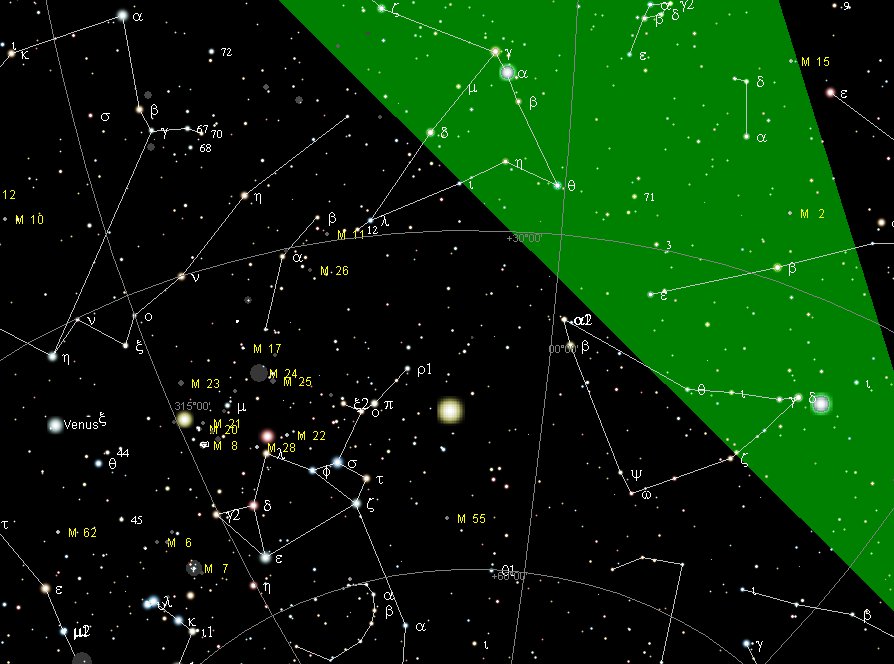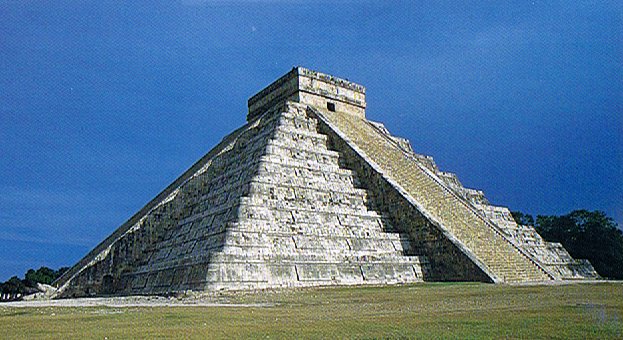49. The planet Mars is bound
to
arrive at λ
Sagittarii in the Tea-pot in January 13 AD 2024:
|
ORBIT OF MARS AD 2023-2024 |
|
April 14 (180
- 76) |
*16 |
April 30 (196 - 76) |
*133 |
Dec 7 (*261 = 341 - 80) |
|
Mebsuta (*100) |
Pollux (*116) |
ω
Ophiuchi (*249) |
|
Ga2-6
(36) |
Ga2-22 (52) |
Ga7-16
(185 = 265 - 80) |
 |
 |
 |
|
APRIL 26 (116) |
MAY
12 (132) |
SEPT 22 (EQUINOX) |
|
*30 |
Jan 13 (378 = 454 - 76) |
|
Jan 22 (463 - 76) |
|
Kaus Borealis (*279) |
Mebsuta (*100) |
|
Ga8-12
(215) |
Ga8-15 (36 + 182) |
 |
 |
|
OCT 22 (295) |
OCT 25 (116 +
182) |

 |
 |
 |
 |
| Ga8-12 |
Ga8-13 (216) |
Ga8-14 |
Ga8-15 |
|
PLACE OF THE SUN |
|
KAUS BOREALIS = λ Sagittarii (279.3)
Dec 7 AD 2023 (*261 → 9 * 29)
MERCURY
Jan 13 AD 2024 (300 + 78 = 378 → Saturn)
MARS |
ν Pavonis (280.4), κ Cor. Austr. (280.9)
*239.0 = *280.4 - *41.4 |
Abhijit-22 (Victorious)
θ Cor. Austr. (281.0), VEGA = α Lyrae (281.8) |
No star listed (282) |
| Dec 25 |
26 (360) |
27 |
28 |
| 'Nov 28 |
29 (333) |
30 (*254) |
'Dec 1 |
| "Nov 14 |
15 |
16 (*240) |
17 (321) |
|
OCT 22 (295) |
23 (*216) |
24 |
25 |
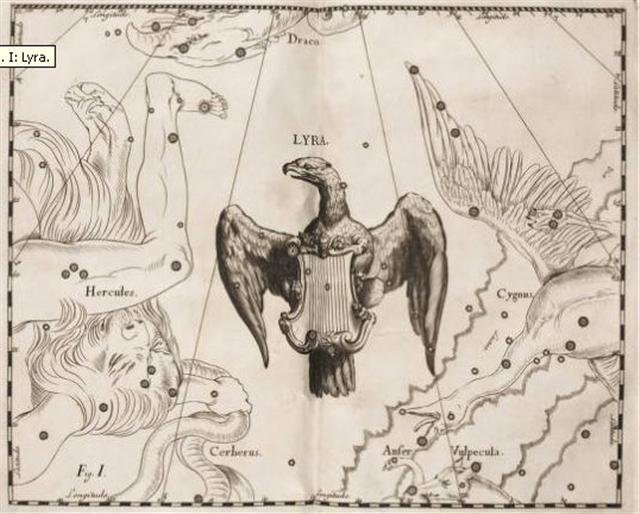 |
|
THE NAKSHATRA
VIEW: |
| β Monocerotis, ν Gemini (97.0) |
No star listed (98) |
ψ3 Aurigae (99.4), ψ2 Aurigae (99.5)
GEMMA (α Cor. Bor.) |
ψ4 Aurigae (100.5), MEBSUTA (Outstretched) = ε Gemini (100.7) |
|
... In other words, the ancient Druidic religion based on the oak-cult will be swept away by Christianity and the door - the god Llyr - will languish forgotten in the Castle of Arianrhod, the Corona Borealis. This helps us to understand the relationship at Rome of Janus and the White Goddess Cardea who is ... the Goddess of Hinges who came to Rome from Alba Longa. She was the hinge on which the year swung - the ancient Latin, not the Etruscan year - and her importance as such is recorded in the Latin adjective cardinalis - as we say in English 'of cardinal importance - which was also applied to the four main winds; for winds were considered as under the sole direction of the Great Goddess until Classical times ... |
| June 26 (177) |
27 |
28 (*464) |
29 (*100) |
| 'May 30 (150) |
31 (*436) |
'June 1 |
2 (*73) |
| "May 16 (136) |
17 (*422) |
18 |
19 (*59) |
| APRIL 23 |
24 (*399) |
25 (480) |
26 (*36) |
 |
 |
 |
 |
| Ga2-3 |
Ga2-4 |
Ga2-5 (35) |
Ga2-6 |
Here the sleepy (cfr French dormir) dormouse
(→ door-mouse)
told about another place, far down at the bottom of
a well, implying in a way he was there, at least in
his mind, in his head:

... 'Tell us a story!' said
the March Hare. 'Yes, please do!' pleaded Alice.
'And be quick about it', added the Hatter, 'or you'll be
asleep again before it's done.' 'Once upon a time there
were three little sisters', the Dormouse began in a
great hurry: 'and their names were Elsie [ε], Lacie [λ],
and Tillie [τ]; and they lived at the bottom of a well —
'
I suggest this place in his mind (ψ)
might allude to the Monoceros constellation.
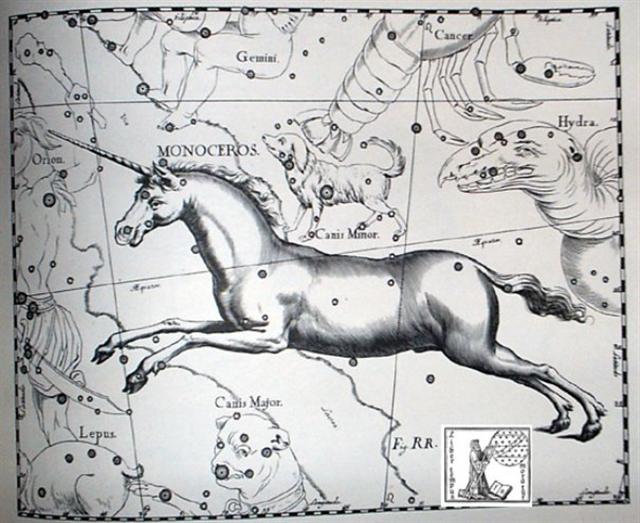
Although the Greek letters assigned for the stars appear
not to be perfectly in order it is always possible to
imagine:
|
 |
'2
|
 |
'2
|

|
*10
|
 |
|
Ga8-8 (211) |
Ga8-10 (213) |
Ga8-12
(215) |
Ga8-22 (210 + 15) |
|
MONOCEROTIS |
|
γ
(*93) |
|
εlsie (*95) |
|
β → λazy (*97) |
|
δ → τillie (*107) |
|
Polis = μ
(*275.9) |
Kaus Medius = δ
(*277) |
Kaus
Borealis = λ
(*279) |
τ
(*289) |
|
SAGITTARIUS |
|
Egyptian water ripples |
 |
Phoenician
mēm |
 |
Greek
mu |
Μ (μ) |
... Behind
me, towering
almost 100
feet into
the air, was
a perfect
ziggurat,
the Temple
of
Kukulkan.
Its four
stairways
had 91 steps
each. Taken
together
with the top
platform,
which
counted as a
further
step, the
total was
365. This
gave the
number of
complete
days in a
solar year.
In addition,
the
geometric
design and
orientation
of the
ancient
structure
had been
calibrated
with
Swiss-watch
precision to
achieve an
objective as
dramatic as
it was
esoteric: on
the spring
and autumn
equinoxes,
regular as
clockwork,
triangular
patterns of
light and
shadow
combined to
create the
illusion of
a giant
serpent
undulating
on the
northern
staircase
...
|
|
Egyptian
door |
 |
Phoenician
dalet |
 |
Greek
delta |
Δ (δ) |
... Delta
(uppercase Δ, lowercase δ)
... is the fourth letter of
the Greek alphabet. In the
system of Greek numerals it
has a value of 4. It was
derived from the Phoenician
letter Dalet.
Letters that
come from delta include
Latin D and Cyrillic Д. A
river delta (originally, the
Nile River delta) is so
named because its shape
approximates the upper-case
letter delta (the shape is a
triangle) ...
Dalet
(dāleth, also spelled
Daleth or Daled)
is the fourth letter of many
Semitic alphabets ... The
letter is based on a glyph
of the Middle Bronze Age
alphabets, probably called
dalt 'door' (door in
Modern Hebrew is delet),
ultimately based on a
hieroglyph depicting a door.

... Sorrowing, then, the two
women placed Osiris's coffer
on a boat, and when the
goddess Isis was alone with
it at sea, she opened the
chest and, laying her face
on the face of her brother,
kissed him and wept. The
myth goes on to tell of the
blessed boat's arrival in
the marshes of the Delta,
and of how Set, one night
hunting the boar by the
light of the full moon,
discovered the sarcophagus
and tore the body into
fourteen pieces, which he
scattered abroad; so that,
once again, the goddess had
a difficult task before her.
She was assisted, this time,
however, by her little son
Horus, who had the head of a
hawk, by the son of her
sister Nephtys, little
Anubis, who had the head of
a jackal, and by Nephtys
herself, the sister-bride of
their wicked brother Set.
Anubis, the elder of the two
boys, had been conceived one
very dark night, we are
told, when Osiris mistook
Nephtys for Isis; so that by
some it is argued that the
malice of Set must have been
inspired not by the public
virtue and good name of the
noble culture hero, but by
this domestic inadventure.
The younger, but true son,
Horus, on the other hand,
had been more fortunately
conceived - according to
some, when Isis lay upon her
dead brother in the boat,
or, according to others, as
she fluttered about the
palace pillar in the form of
a bird.
The four bereaved and
searching divinities, the
two mothers and their two
sons, were joined by a
fifth, the moon-god Thoth
(who appears sometimes in
the form of an ibis-headed
scribe, at other times in
the form of a baboon), and
together they found all of
Osiris save his genital
member, which had been
swallowed by a fish. They
tightly swathed the broken
body in linen bandages, and
when they performed over it
the rites that thereafter
were to be continued in
Egypt in the ceremonial
burial of kings, Isis fanned
the corpse with her wings
and Osiris revived, to
become the ruler of the
dead. He now sits
majestically in the
underworld, in the Hall of
the Two Truths, assisted by
forty-two assessors, one
from each of the principal
districts of Egypt; and
there he judges the souls of
the dead. These confess
before him, and when their
hearts have been weighed in
a balance against a feather,
receive, according to their
lives, the reward of virtue
and the punishment of sin
...
|
But the path of the planet Mars must continue
uninterrupted, beyond the point of
λ Sagittarii, beyond January 13 AD 2024.
Nothing
noteworthy seems to occur until we reach February 20 AD
2024, where both Mars and Venus are together entering
into the
constellation of the Goat:

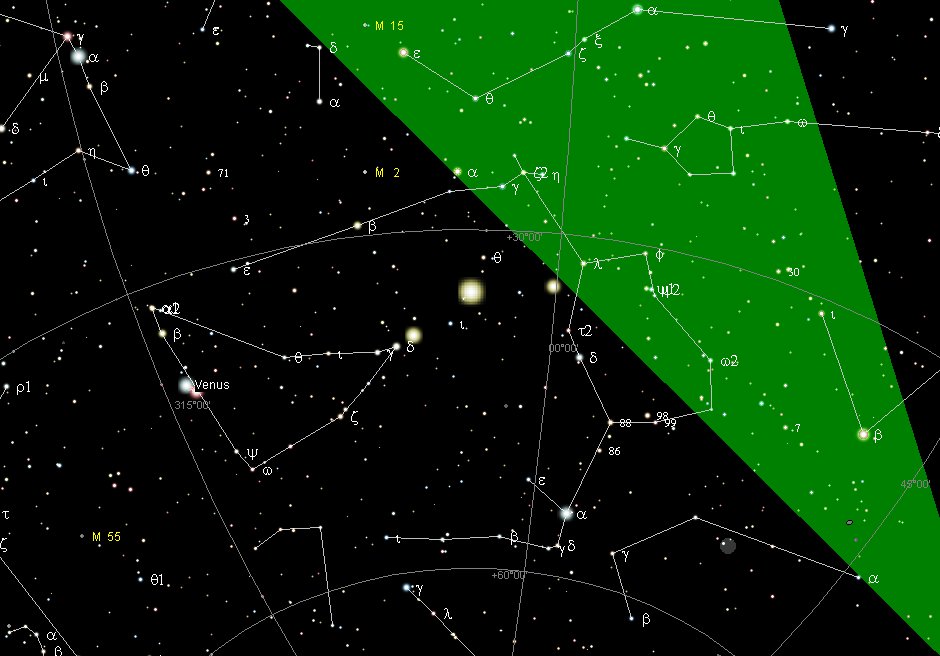
Mercury has just left the Capricorn behind and farther
ahead, beyond the symbol for the Sun, is also Saturn.
And in the G text we should therefore search for the
heliacal place of ο
Capricorni:
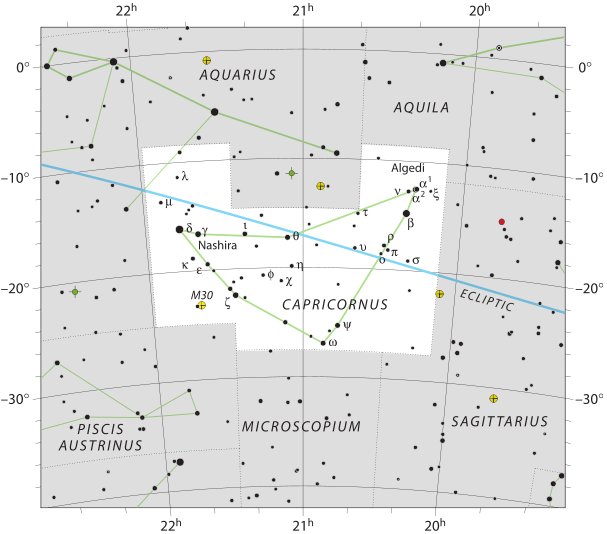
In
my star list we can find
ο Capricorni at *311.2, which we have to adjust to
my assumed era for rongorongo by reducing with *1 right
ascension day.
The creator of the G text
has decided to put this significant place (where Heka
was culminating) after the end of side a:
 |
 |
 |
 |
 |
 |
|
Gb1-14 |
Gb1-15 |
Gb1-16 |
Gb1-17 (2 *
123) |
Gb1-18 |
Gb1-19 (248) |
|
GREDI (Goat) |
|
MINTAKA (δ
Orionis)
ARNEB (α
Leporis) |
ο Capricorni
ALNILAM (ε
Orionis)
HEKA (λ
Orionis)
Febr 20 AD 2024
MARS |
ALNILAK (ζ
Orionis)
PHAKT (α
Columbae) |
|
|
Jan 22 |
23 (*308) |
24 |
25 →
21
+ 4 |
26 (*311) |
27 (392) |
|
°Jan 18 |
19 (*304) |
20 |
21 |
22 |
23 (388) |
|
'Dec 26 |
27 |
28 |
29 |
30 (364) |
31 (*285) |
|
"Dec 12 |
13 |
14 (348) |
15 |
16 (*270) |
17 |
|
NOV 19 |
20 (324) |
21 |
22 |
23 |
24 (*248) |
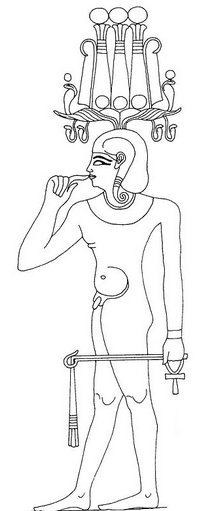
|
